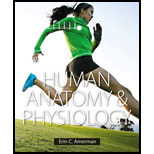
The central nervous system is responsible for:
a. integrative functions.
b. sensory functions.
c. motor functions.
d. Both b and c are correct.
Introduction:
In human beings, the central nervous system consists of the brain and the spinal cord. Brain is a large and delicate organ, which is placed inside the cranial cavity. It contains several ventricles filled with protective CSF (cerebrospinal fluid). The four divisions of the brain are cerebrum, diencephalon, cerebellum, and brainstem, which connect the brain to the spinal cord.
Answer to Problem 1CYR
Correct answer:
The central nervous system is responsible for integrative functions.
Explanation of Solution
Explanation for the correct answer:
Option (a) states that integrative functions are carried out by the central nervous system. Integrative functions include higher mental functions, such as use of language and learning, maintenance of homeostasis, planning and monitoring movements, decision making, and interpretation of sensory stimuli. These functions are exclusively performed by different components of CNS. Hence, option (a) is correct.
Explanation for the incorrect answers:
Option (b) states that sensory functions of the body are performed by the CNS. These functions include detection of all the sensory stimuli from the sense organs, which is performed by the nerves of peripheral nervous system. So, option (b) is an incorrect option.
Option (c) states that motor functions are performed by the CNS. The peripheral nervous system (PNS) consists of motor neurons. All the motor functions of the body, such as stimulation of muscle contraction, or secretion by a gland are thus performed by the peripheral nervous system. So, option (c) is an incorrect option.
Option (d) states that both sensory and motor functions are performed via the CNS. However, they are performed by the PNS, which consists of several cranial and spinal nerves. So, option (d) is an incorrect option.
Hence, options (b), (c), and (d) are incorrect.
Thus, it can be concluded that integrative functions of the body are performed by the central nervous system (CNS). On the other hand, sensory and motor functions of the body are not performed via the central nervous system, as they involve PNS.
Want to see more full solutions like this?
Chapter 12 Solutions
Human Anatomy & Physiology
Additional Science Textbook Solutions
Biology: Life on Earth (11th Edition)
Chemistry: An Introduction to General, Organic, and Biological Chemistry (13th Edition)
College Physics: A Strategic Approach (3rd Edition)
Applications and Investigations in Earth Science (9th Edition)
Campbell Biology (11th Edition)
Concepts of Genetics (12th Edition)
- series of two-point crosses were carried out among six loci (a, b, c, d, e and f), producing the following recombination frequencies. According to the data below, the genes can be placed into how many different linkage groups? Loci a and b Percent Recombination 50 a and c 14 a and d 10 a and e 50 a and f 50 b and c 50 b and d 50 b and e 35 b and f 20 c and d 5 c and e 50 c and f 50 d and e 50 d and f 50 18 e and f Selected Answer: n6 Draw genetic maps for the linkage groups for the data in question #5. Please use the format given below to indicate the genetic distances. Z e.g. Linkage group 1=P____5 mu__Q____12 mu R 38 mu 5 Linkage group 2-X_____3 mu__Y_4 mu sanightarrow_forwardWhat settings would being able to isolate individual bacteria colonies from a mixed bacterial culture be useful?arrow_forwardCan I get a handwritten answer please. I'm having a hard time understanding this process. Thanksarrow_forward
- Biology How many grams of sucrose would you add to 100mL of water to make a 100 mL of 5% (w/v) sucrosesolution?arrow_forwardWhich marker does this DNA 5ʹ AATTGGCAATTGGCAATTGGCAATTGGCAATTGGCAATTGGCAATTGGC 3ʹ show?arrow_forwardThe Z value of LOD for two genes is 4, what does it mean for linkage and inheritance?arrow_forward
- Biology How will you make a 50-ul reaction mixture with 2uM primer DNA using 10 uM primer DNA stocksolution and water?arrow_forwardBiology You’re going to make 1% (w/v) agarose gel in 0.5XTBE buffer 100 ml. How much agarose are you goingto add to 100 ml of buffer? The volume of agaroseis negligible.arrow_forwardBiology How will you make a 50-ul reaction mixture with0.2 mM dNTP using 2-mM dNTP stock solution andwater?arrow_forward
 Concepts of BiologyBiologyISBN:9781938168116Author:Samantha Fowler, Rebecca Roush, James WisePublisher:OpenStax College
Concepts of BiologyBiologyISBN:9781938168116Author:Samantha Fowler, Rebecca Roush, James WisePublisher:OpenStax College Medical Terminology for Health Professions, Spira...Health & NutritionISBN:9781305634350Author:Ann Ehrlich, Carol L. Schroeder, Laura Ehrlich, Katrina A. SchroederPublisher:Cengage Learning
Medical Terminology for Health Professions, Spira...Health & NutritionISBN:9781305634350Author:Ann Ehrlich, Carol L. Schroeder, Laura Ehrlich, Katrina A. SchroederPublisher:Cengage Learning Biology (MindTap Course List)BiologyISBN:9781337392938Author:Eldra Solomon, Charles Martin, Diana W. Martin, Linda R. BergPublisher:Cengage Learning
Biology (MindTap Course List)BiologyISBN:9781337392938Author:Eldra Solomon, Charles Martin, Diana W. Martin, Linda R. BergPublisher:Cengage Learning Human Physiology: From Cells to Systems (MindTap ...BiologyISBN:9781285866932Author:Lauralee SherwoodPublisher:Cengage Learning
Human Physiology: From Cells to Systems (MindTap ...BiologyISBN:9781285866932Author:Lauralee SherwoodPublisher:Cengage Learning





